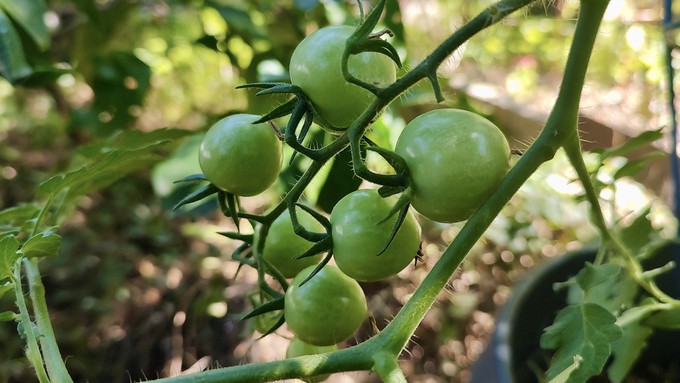
Triple-digit heat again challenges tomatoes, squash

These tomatoes were pollinated during the recent weather break -- before this week's triple-digit heat. But will they have time to mature before fall weather settles in? Debbie Arrington
To pull or not to pull? That’s the question after high temperatures just about finished off our summer crops.
Sacramento started September with a string of triple-digit days. On Friday (Sept. 6), the Sacramento region remained under a heat advisory until 8 p.m. So far this month, daytime highs averaged just under 96 degrees – almost five degrees above normal for this week.
This heat browned leaves and vines on many plants. It also brought bee activity (so crucial for pollination) to a standstill. And that impacted squash.
In this weather, zucchini develop little baby squash that start out OK, but never seem to develop. It rots before it reaches 4 or 5 inches long. The Brits call it “courgette rot,” referring to the English name for zucchini. It’s due to insufficient pollination.
Extreme heat complicates bees’ lives. If temperatures top 100 degrees (as it has almost daily this month), worker bees need to bring water back to their hives, from one quart to a gallon a day. They’re too busy to pollinate.
So, female zucchini blossoms – which start forming baby squash before the bees arrive – never get the attention they need from pollinators. Without proper pollination, the squash rot before they mature. This issue can happen to other cucurbits as well such as crookneck squash and pumpkins.
Tomatoes depend on wind, not bees, for pollination. But on days above 95 degrees, tomato pollen dries out before it ever has a chance to set fruit.
I’ve been nursing my vines along in hopes of fall tomatoes. Our red-hot July (the hottest July on record in Sacramento) prevented fruit set during a time when tomatoes are usually at their most productive. We had just enough of a break in the weather in August for my tomatoes to set some fruit; those baby green tomatoes are forming now. But will they have enough time to mature?
Although these hot days feel like midsummer, chilly fall weather is not far away. Those baby toms need at least six to eight more weeks of warmth – just not all this heat.
That leads back to the original question: To pull or not to pull? The plants with baby tomatoes or squash – or flowers – can stay put for a little longer. Even if those green tomatoes never turn red on the vine, they may still ripen indoors on the kitchen counter.
Trim off dead or browned leaves and vines, so plants can concentrate on wrapping up their production. Give the bushes a deep watering and some fertilizer high in phosphates such as bone meal. (Hope springs eternal.)
Otherwise, turn the page – and pull out those faded summer crops. Remember: September is an excellent time to plant cool-season vegetables.
Comments
0 comments have been posted.Sacramento Digs Gardening to your inbox.
Sites We Like
Garden Checklist for week of Nov. 3
November still offers good weather for fall planting:
* If you haven't already, it's time to clean up the remains of summer. Pull faded annuals and vegetables. Prune dead or broken branches from trees.
* Now is the best time to plant most trees and shrubs. This gives them plenty of time for root development before spring growth. They also benefit from fall and winter rains.
* Set out cool-weather annuals such as pansies and snapdragons.
* Lettuce, cabbage and broccoli also can be planted now.
* Plant garlic and onions.
* Keep planting bulbs to spread out your spring bloom. Some possible suggestions: daffodils, crocuses, hyacinths, tulips, anemones and scillas.
* This is also a good time to seed wildflowers and plant such spring bloomers as sweet pea, sweet alyssum and bachelor buttons.
* Rake and compost leaves, but dispose of any diseased plant material. For example, if peach and nectarine trees showed signs of leaf curl this year, clean up under trees and dispose of those leaves instead of composting.
* Save dry stalks and seedpods from poppies and coneflowers for fall bouquets and holiday decorating.
* For holiday blooms indoors, plant paperwhite narcissus bulbs now. Fill a shallow bowl or dish with 2 inches of rocks or pebbles. Place bulbs in the dish with the root end nestled in the rocks. Add water until it just touches the bottom of the bulbs. Place the dish in a sunny window. Add water as needed.
* Give your azaleas, gardenias and camellias a boost with chelated iron.
* For larger blooms, pinch off some camellia buds.
* Prune non-flowering trees and shrubs while dormant.
* To help prevent leaf curl, apply a copper fungicide spray to peach and nectarine trees after they lose their leaves this month. Leaf curl, which shows up in the spring, is caused by a fungus that winters as spores on the limbs and around the tree in fallen leaves. Sprays are most effective now.